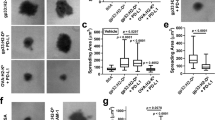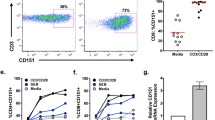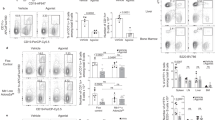Abstract
Azodicarbonamide was recently identified as a new anti-HIV agent that targets the zinc finger domains of the HIV-1 NCp7 nucleocapsid protein1,2,3. Here, we demonstrate that azodicarbonamide inhibits in a dose-dependent manner the responses of purified human CD4+ T lymphocytes stimulated either by monoclonal antibodies against CD3 and CD28 or by allogeneic dendritic cells. These suppressive effects involve a direct action on the calcium mobilization machinery, as azodicarbonamide strongly inhibited the calcium influx induced either by antibodies against CD3 and CD28 or the chemokine RANTES, as well as by thapsigargin, an activator of depletion-activated calcium channels. In vivo, administration of azodicarbonamide into mice blunted their response to polyclonal T-cell activation induced by the injection of monoclonal antibody against CD3 and resulted in delayed rejection of skin allografts. In addition to its anti-HIV properties, azodicarbonamide is a new immunosuppressive agent that might have therapeutic applications in T cell-mediated inflammatory disorders.
This is a preview of subscription content, access via your institution
Access options
Subscribe to this journal
Receive 12 print issues and online access
$209.00 per year
only $17.42 per issue
Buy this article
- Purchase on Springer Link
- Instant access to full article PDF
Prices may be subject to local taxes which are calculated during checkout



Similar content being viewed by others
References
Rice, W.G. et al. Azodicarbonamide inhibits HIV-1 replication by targeting the nucleocapsid protein. Nature Med. 3, 341–345 (1997).
Huang, M. et al. Anti-HIV agents that selectively target retroviral nucleocapsid protein zinc fingers without affecting cellular zinc finger proteins. J. Med. Chem. 41, 1371–1381 (1998).
Vandevelde, M., Witvrouw, M., Sprecher, S., De Clerq, E. & Tassignon, J. P. ADA, a potential anti-HIV drug. AIDS Res. Hum. Retroviruses 12, 567–568 (1996).
Crabtree, G.R. & Clipstone, N. A. Signal transmission between the plasma membrane and nucleus of T lymphocytes. Annu. Rev. Biochem. 63, 1045–1083 (1994).
Lewis, R.S. & Cahalan, M.D. Potassium and calcium channels in lymphocytes. Annu. Rev. Immunol. 13, 623–653 (1997).
Bacon, K.B. Calcium mobilization and phosphoinositide turnover as measure of chemokine receptor function in lymphocytes. Methods Enzymol. 288, 362–383 (1995).
Alegre, M.L. et al. Cytokine release syndrome induced by the 145-2C11 anti-CD3 monoclonal antibody in mice: prevention by high doses of methylprednisolone. J. Immunol. 146, 1184–1191 (1991).
Rosenberg, A.S. Cellular basis of skin allograft rejection: an in vivo model of immune-mediated tissue destruction. Annu. Rev. Immunol. 10, 333–358 (1992).
Thali, M. Cyclosporins: immunosuppressive drugs with anti-HIV-1 activity. Mol. Med. Today 1, 287–291 (1995).
Ichimura, H. & Levy, J.A. Polymerase substrate depletion: a novel strategy for inhibiting the replication of the human immunodeficiency virus. Virology 211, 554–560 (1995).
Jaworowski, A. & Crowe, S.M. Does HIV cause depletion of CD4+ T cells in vivo by the induction of apoptosis? Immunol. Cell. Biol. 1, 90–98 (1999).
Baus, E., Urbain, J., Leo, O. & Andris, F. Flow cytometric measurement of calcium influx in murine T cell hybrids using Fluo-3 and an organic-anion transport inhibitor. J. Immunol. Methods 173, 41–47 (1994).
Tsien, R.Y., Pozzan, T. & Rink, T.J. Calcium homeostasis in intact lymphocytes: cytoplasmic free calcium monitored with a new intracellular trapped fluorescent indicator. J. Cell. Biol. 94, 325–334 (1982).
Acknowledgements
This study was supported by grants from the government of the Brussels Region, UCB-Pharma, and the Fonds National de la Recherche Scientifique (Belgium)
Author information
Authors and Affiliations
Corresponding author
Rights and permissions
About this article
Cite this article
Tassignon, J., Ismaili, J., Moine, A. et al. Azodicarbonamide inhibits T-cell responses in vitro and in vivo. Nat Med 5, 947–950 (1999). https://doi.org/10.1038/11392
Received:
Accepted:
Issue Date:
DOI: https://doi.org/10.1038/11392



